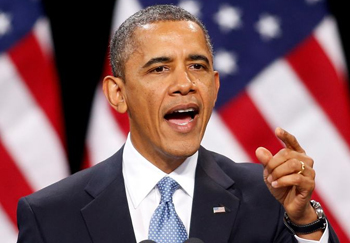Washington, Sep 11: President Barack Obama told Americans on Wednesday he had authorized U.S. air strikes for the first time in Syria and more attacks in Iraq in a broad escalation of a campaign against the Islamic State militant group.
 Obama's decision to launch attacks inside Syria, which is embroiled in a three-year civil war, showed the seriousness of the threat American officials see from Islamic State. A year ago, the president shied away from air strikes against Syria's government for its use of chemical weapons against Syrians.
Obama's decision to launch attacks inside Syria, which is embroiled in a three-year civil war, showed the seriousness of the threat American officials see from Islamic State. A year ago, the president shied away from air strikes against Syria's government for its use of chemical weapons against Syrians.
Obama laid out his emerging plan for tackling the group in a widely anticipated White House speech, two weeks after coming under fire for saying: "We don't have a strategy yet" for the group in Syria and six months after declaring that groups like Islamic State were minor players.
"Our objective is clear: we will degrade, and ultimately destroy, ISIL through a comprehensive and sustained counter-terrorism strategy," Obama said, using an acronym for Islamic State.
He said he would hunt down Islamic State militants "wherever they are."
"That means I will not hesitate to take action against ISIL in Syria, as well as Iraq. This is a core principle of my presidency: if you threaten America, you will find no safe haven," he said.
He said he would expand the list of targets inside Iraq beyond several isolated areas. He will send 475 more American advisers to help Iraqi forces, joining more than 1,000 already there. They will not engage in combat.
Training Vamps in Saudi Arabia
In a significant move that could help rally Gulf Arab states behind the U.S.-led coalition, key ally Saudi Arabia will host inside its territory a U.S. training effort for Syrian rebels, senior U.S. officials said. The effort is dependent on the U.S. Congress approving $500 million to train and arm the rebels.
The Saudi decision emerged after Obama spoke by phone earlier in the day with Saudi King Abdullah, who has pressed the American government to do more resolve the Syrian conflict.
Obama has staked much of his foreign policy record on having extracted U.S. forces from Iraq after running for president in 2008 on a pledge to end what he felt was an unnecessary conflict begun by his Republican predecessor, George W. Bush.
Obama's move to deepen U.S. involvement in Iraq in its fight against Islamic State follows opinion polls that show Americans feel the president has been too cautious in tackling the group. Obama has struggled with a host of foreign policy crises this year, bringing his overall public approval record down to near record lows of about 40 percent.
Obama vowed he would not send large numbers of U.S. combat forces to the region but would rely instead on assistance from a broad coalition involving Sunni-led governments in the region and Western allies.
U.S. officials want allies to join in attacks on the group as well as in training and equipping Iraqi forces and Syrian rebels, providing humanitarian relief and intelligence.
Building an allied coalition
What specifically each nation will do in the coalition remains to be hammered out. Secretary of State John Kerry is meeting Gulf allies in the region and Obama is to host a leaders' security conference at the U.N. General Assembly in two weeks with the aim of fleshing out duties of the coalition.
Before the focus on Islamic State, Obama for months had been cool to the notion of arming the poorly organized Syrian rebels, fearing weapons provided them could end up in the wrong hands.
But he now needs the rebels to become strong enough to hold ground cleared by U.S. air strikes, just as Iraqi forces are doing in Iraq.
U.S. officials pushed back hard against the notion that striking Islamic State strongholds in Syria would unintentionally help President Bashar al-Assad. They said the Sunni-majority areas in the eastern part of the country the militants hold are not places where Assad loyalists would be able to take advantage to regain control.
Islamic State has carved out what it calls a "caliphate" from broad areas in Iraq and Syria and uses savage methods that have included the beheading of many prisoners, including two Americans.
"This counter-terrorism campaign will be waged through a steady, relentless effort to take out ISIL wherever they exist using our air power and our support for partner forces on the ground," Obama said.





Comments
Add new comment